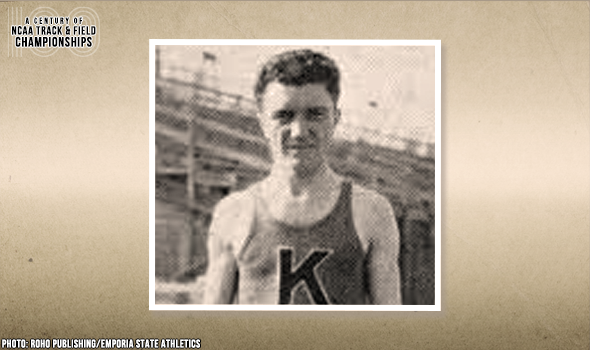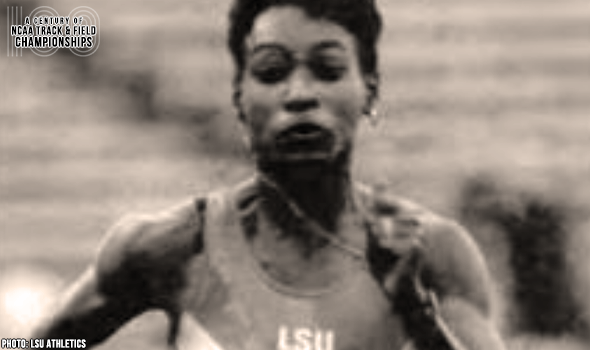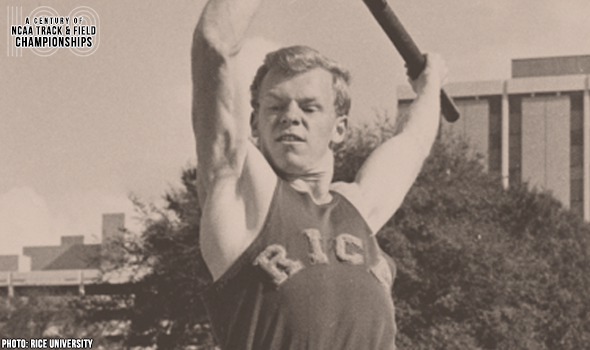
Levins Kicked Past Competition In 5K/10K
Through 4600 meters of the 5000-meter final and 9600 meters of the 10,000-meter final at the 2012 NCAA Division I Outdoor Track & Field Championships, it was still anybody’s race. But over the final 400 meters of each competition, Cam Levins of Southern Utah ruled supreme.
Eight years ago, Levins used blistering kicks to complete what was, at the time, the 11th distance double in meet history. It polished off a dream redshirt senior year that ended with him hoisting The Bowerman, as collegiate track & field’s most outstanding male athlete.
Just about six weeks before the NCAA Outdoor Championships, Levins staked his claim as the favorite for both of those events with a pair of all-time marks in late April. First it was at the Mt. SAC Relays where he went 13:18.47 in the 5000 and outkicked Lawi Lalang of Arizona for the fifth best performance in collegiate history. Then, he won a stacked 10,000-meter race at the Payton Jordan Invitational in 27:27.96 for the second fastest mark in collegiate history behind Sam Chelanga’s two-year-old all-time best of 27:08.49.
The first race on Levins’ NCAA docket was the 10K. It just so happened to be the final event of the evening, as if they fully expected to see fireworks to close out the night.
After 22 laps, four athletes were bunched tightly together. That number whittled down to three with 800 meters to go and then it remained that way until the bell. Once the clanging echoed through the seasonably cool summer night, Levins dropped the hammer and blistered the track for a 58.06-second final lap on his way to a 28:07.14 victory, which was the fastest winning mark at the meet since 1984 (Ed Eyestone, BYU).
Two nights later, Levins was more than happy to let a kicker’s race develop in the 5K.
“I just wanted to wait for the last couple-hundred meters, put myself in position, wait for someone to respond and just go – just sorta use my intuition rather than an exact race I might have planned,” Levins told Sieg Lindstrom of Track & Field News.
Patience paid off for Levins as his 54.29-second capper turned what had been six men within one second of the lead at the bell into a one-second victory. Paul Chelimo of UNC-Greensboro tried to go with him – and split 54.89 between 4600 and 5000 meters – but Levins had an extra gear, even after a challenging 10K two nights prior.
“I’m really, really happy,” Levins told Tom Zulewski of The Spectrum & Daily News of St. George, Utah after the race. “To be able to come back from the 10,000 and win the 5000 is awesome. It’s what I wanted all season. To pull off the double is more than I could imagine.”
The NCAA and collegiate track & field will mark a momentous milestone in the spring of 2021 -- the 100th anniversary of the NCAA Championships and with that, the NCAA Track & Field Championships. In June 1921, the University of Chicago hosted the first track & field championships in NCAA history.
This point can’t be emphasized enough: Not only was the event the first for NCAA track & field, but the first championships for any sport under the sponsorship of the NCAA.
To celebrate, over each of the next 365 days, the U.S. Track & Field and Cross Country Coaches Association (USTFCCCA) will celebrate moments, student-athletes, and coaches that have made a century’s worth of championships special. From humble beginnings to important historical milestones to the modern-day, collegiate track & field has evolved with the American society.
The 2021 edition of the NCAA Division I Outdoor Track & Field Championships begin with preliminary round action on May 27-29 in Jacksonville, Fla., and College Station, Texas. The championships final site and culmination of the celebration is slated for June 9-12, 2021 at the newly rebuilt Hayward Field in Eugene, Ore.

Clemson’s Ross Kept Getting Faster In 1995
Duane Ross PR’d twice in the 110H at the 1995 NCAA DI Outdoor T&F Championships. When Ross won in 13.32, he became the No. 3 performer in collegiate history.

Illinois’ Kerr Went Back-To-Back At NCAAs
George Kerr won back-to-back 800/880 titles at the NCAA Outdoor T&F Championships in 1959 & 1960. Kerr set a meet record of 1:46.4 in the 800 meters in 1960.

UCLA’s Baucham Bounded To TJ CR In 2005
Candice Baucham won the triple jump at the 2005 NCAA DI Outdoor T&F Championships with a collegiate record of 14.07m (46-2). Baucham took the event by more than one foot.

San Romani Went From Unknown To Legend
Archie San Romani won back-to-back 1500/mile crowns at the NCAA Outdoor T&F Championships in 1935 & 1936.

Auburn’s Glance Made Them Look Twice
Harvey Glance completed the 100-200 double as a freshman at the 1976 NCAA DI Outdoor T&F Championships. He set a meet record of 10.16 in the 100.

Nova’s Rhines Did NCAA 5K Three-Peat
Jen Rhines was the first female athlete in the history of the NCAA DI Outdoor T&F Championships to win three consecutive 5K titles.

Georgia’s Erm Cruised To 2019 Decathlon Title
Johannes Erm won the decathlon at the 2019 NCAA DI Outdoor T&F Championships by 342 points with his 8352 total. That was also the fifth-best score in meet history.

McMillen Adapted, Set 1500 MR In 1952
Bob McMillen set a meet record in the 1500 meters of 3:50.7 at the 1952 NCAA Outdoor Track & Field Championships.

LSU’s Duhaney Destroyed NCAA 200 Field In 1992
Dahlia Duhaney owns the largest margin of victory in meet history in the 200 with her 0.44-second winner at the 1992 NCAA DI Outdoor T&F Championships.

Rice’s Roberts Cooked Up Pole Vault Greatness
Dave Roberts was the second man to win three consecutive pole vault titles at the NCAA DI Outdoor T&F Championships, doing so from 1971 to 1973.

